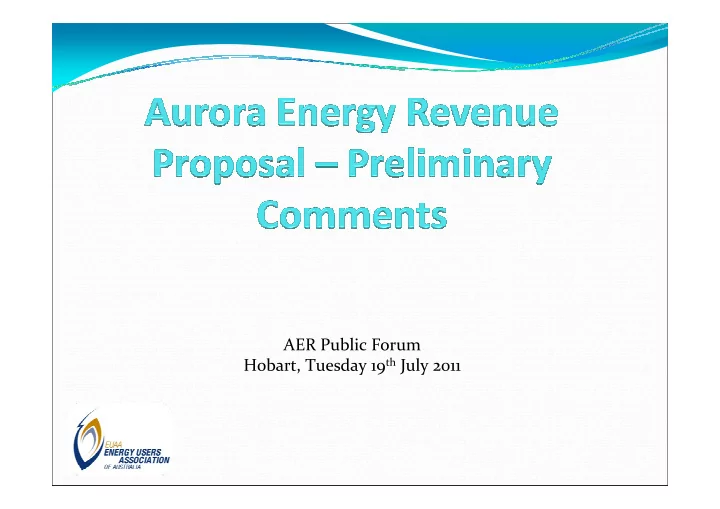

AER Public Forum Hobart, Tuesday 19 th July 2011
Aurora Energy � Tasmania’s load is approximately 11,500GWh. � Aurora Energy (distribution) currently supply 40% of Tasmania’s total consumption to its customers. � The remainder is supplied by Transend’s transmission network. � Transend’s transmission network goes down to a lower voltage level than other TNSPs. � The classification of 110kv lines as transmission lines in Tasmania impacts the cost of capex and opex.
Customer Connections � Customer connection growth is forecast to increase by 50% over the next regulatory period. � Out of step with the forecast growth of the mainland states over their current regulatory periods. � Prima facie we find this difficult to accept? � Aurora Energy did not provide their actual customer connections in their regulatory proposal but the mainland DNSPs did.
Capital Expenditure � Aurora have asked for capex totalling $672m ($2010). � 13% increase on the allowed expenditure in current period. � Average spend of $470 per customer for the next regulatory period. Is it driven by high growth in customer connections (refer prev slide)? � For the period 2004 to 2014 Aurora’s average capex per customer is higher than its peers in Victoria (129% ) & also SA. But lower than NSW & Qld.
Capex Per Customer � On average Aurora’s actual/forecast capex is 78% greater than the combined average spend of SP Ausnet, Powercor and Jemena. ( for the period 2004-2014)
Operational Expenditure � Forecast opex totalling $340m ($2009-10). � Average spend per customer $231 over the next regulatory period (see chart). � From 2004-2014 Aurora will spend 35% on average more opex per customer than the Victorian distributors. (Note: The 2008 result is reflects Aurora reporting their 2008 opex as a half year.)
Revenue Per Customer � Aurora forecast $974 (in real terms) revenue per customer for the next regulatory period � A real increase of 30% from the current regulatory period. � Aurora have forecast a real increase of 10.69% in the first year of the regulatory period; then declining by 0.12% pa for the remainder of the period. (based on the X factors) � Revenue per customer higher than Vic & SA but lower than NSW & Qld
Indicative Average Prices ($/MWh $2010) � Average price of $44/MWh for the current regulatory period. � Average price of $58/MWh for the next regulatory period. � An increase of 32%. This is not good news for Aurora’s customers!
Cost of Capital � Aurora have asked for a 10.33% WACC for the next regulatory period, up from 6.64% granted by OTTER last time. � Traditionally state governments who own electricity networks have used the dividends generated by the businesses as a revenue stream. � In the 2011/12 State Budget the Tasmanian Government is seeking a greater return from those businesses that have the capacity to pay increased dividends. In particular, the State's electricity entities, Aurora Energy Pty Ltd, Hydro Tasmania and Transend. Commencing in 2011-12, the dividend payout ratios will be increased from 50% to 60%. The dividend, tax and Rate Equivalent Income is estimated to be $218.2 million in 2011- 12, an increase of $69.3 million or 46.5 per cent above the 2010-11 Budget estimate of $148.9 million. We do not see this as appropriate at a time of rapidly increasing electricity prices. � Aurora have asked for a cost of debt of 10.07%. � State treasuries issue debt for the networks. Is there really a cost of debt?
Context of Aurora’s Proposal � After reviews of 11 DNSPs on the mainland the AER Chair has acknowledged that there are a number of “short comings” in the regulatory framework. The regime incentivises the businesses to submit revenue proposals that are at the top I. or over what can be considered a reasonable reflection of required expenditure. The rules require all actual capex to be rolled into the asset base at the start of the next II. regulatory period without review of its efficiency even when the business has overspent its allowed expenditures. This results in step-changes in prices at the start of the next regulatory period. The actual cost of capital also incentivises capex overspends if it is below the regulated cost of capital. The AER says it is restricted in the application of the cost of capital due to the rules III. which require the AER to assess the cost of debt against corporate bonds issued in Australia which is not reflective of the actual debt raising activities of the DSNPs. There have been further increases in revenues granted to the DNSPs from appeals to IV. the Australian Competition Tribunal (ACT). The cost of appeal is weighed against the results from a successful outcome and incentivises appealing an AER determination. The cost of an appeal can be recovered from the DNSP’s customers. � As a result, the AER Chair acknowledged that the regulatory framework is a factor in explaining recent electricity price increases. � We point out that it would be unreasonable to end users for this to continue & for it to influence the outcome of this determination.
Final Comments � The EUAA recognises that the Australian Energy Regulator (AER) can only apply the rules to ensure that the revenue proposal from Aurora Energy is prudent and efficient. � However, we would expect the AER to recognise that the impacts mentioned on the previous slide are at work and to look for ways to minimise their influence over Aurora’s network prices. � We also expect rigorous scrutiny of Aurora’s proposals within these rules. � Given this, how does the AER review Aurora’s regulatory proposal in the context of the rules which they know have short-comings? � This is a critical issue for this determination and we would welcome the AER’s views on it (eg, what would the outcome have been if these limitations had not applied?).
Recommend
More recommend